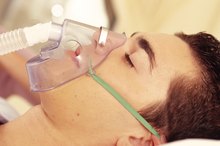Normal Oxygen Levels Using a Pulse Oximeter
Healthcare providers often need to know how well your lungs are functioning in transferring oxygen to your blood. Cells, tissues and organs need oxygen to function, and lack of it can cause a host of complications throughout your body. While testing arterial blood gives an accurate reading of blood oxygenation, pulse oximetry provides a less invasive, painless way to measure oxygen levels.
How Pulse Oximetry Works
Pulse oximeters measure the amount of oxygenated and deoxygenated hemoglobin in arterial blood, which carries oxygen from the lungs to the rest of the body. Each molecule of hemoglobin -- a protein within the red blood cell -- carries 4 molecules of oxygen. When all molecules of hemoglobin are carrying 4 molecules of oxygen, the oxygen saturation level is 100 percent. Oxygenated hemoglobin absorbs more infrared light and deoxygenated blood more red light. A photodetector opposite the light emitter on the pulse oximeter receives the light and calculates the ratio of red to infrared light, which gives the oxygen saturation percentage.
- Pulse oximeters measure the amount of oxygenated and deoxygenated hemoglobin in arterial blood, which carries oxygen from the lungs to the rest of the body.
- When all molecules of hemoglobin are carrying 4 molecules of oxygen, the oxygen saturation level is 100 percent.
Normal Levels
Disadvantages of Pulse Oximetry
Learn More
In a healthy person, oxygen saturation levels in arterial blood fall between 95 and 100 percent, according to the World Health Organization (WHO) 3. A reading below 95 percent in a healthy person with normal lung function indicates low oxygen levels in the blood, a condition medically termed hypoxemia that requires medical investigation.
Oxygen saturation levels less than 90 percent should be considered a medical emergency, WHO advises. Symptoms of hypoxemia, including cyanosis, or a bluish coloring to the skin and mucus membranes, aren't evident until oxygen saturation falls below 90 percent. Early signs of poor oxygenation include rapid or difficult breathing, unexplained restlessness, apprehension or confusion.
- In a healthy person, oxygen saturation levels in arterial blood fall between 95 and 100 percent, according to the World Health Organization (WHO) 3.
Causes of Abnormal Levels
Many disorders can cause lower-than-normal pulse oximeter readings, including health disorders such as chronic obstructive pulmonary disease and heart failure. Acute respiratory disorders such as asthma attacks, pneumonia or a blood clot in the lung also cause low pulse oximeter readings.
Low readings not related to lung disorders can occur in people with impaired circulation, such as those with very low blood pressure or circulatory disorders that affect blood flow to the pulse oximeter site. Low hemoglobin levels, or anemia, can also affect pulse oximetry. Artificially low levels can be seen in people with dark skin, thick nails or cold extremities.
- Many disorders can cause lower-than-normal pulse oximeter readings, including health disorders such as chronic obstructive pulmonary disease and heart failure.
Proper Use of Pulse Oximetry
How to Use a Finger Pulse Oximeter
Learn More
Pulse oximeters are fairly easy to use, both in the hospital setting and at home. The probe, which contains the infrared and red light emitters, can be placed on any area of the body that is translucent enough for the signal to pass through and with adequate arterial blood flow. While the toes or a finger are often used, the earlobe or even the bridge of the nose can be used if circulation to the fingers or toes is poor. The pulse oximeter is generally set to alarm if the oxygen saturation level drops below a set value. The alarm parameters can be reset as necessary.
Reviewed by: Tina M. St. John, M.D.
- Pulse oximeters are fairly easy to use, both in the hospital setting and at home.
- The pulse oximeter is generally set to alarm if the oxygen saturation level drops below a set value.
Related Articles
References
- Best Practices: Evidence-based Nursing Procedures, 2nd Edition; Lippincott Williams and Wilkins
- Medical-Surgical Nursing: Assessment and Management of Clinical Problems, 9th Edition; Sharon L. Lewis, et al.
- Pandya NK, Sharma S. Capnography And Pulse Oximetry. [Updated 2020 Jan 30]. In: StatPearls [Internet]. Treasure Island (FL): StatPearls Publishing; 2020 Jan-. Available from: https://www.ncbi.nlm.nih.gov/books/NBK539754/
- Castro D, Keenaghan M. Arterial Blood Gas. [Updated 2020 Feb 20]. In: StatPearls [Internet]. Treasure Island (FL): StatPearls Publishing; 2020 Jan-. Available from: https://www.ncbi.nlm.nih.gov/books/NBK536919/
- Torp KD, Simon LV. Pulse Oximetry. [Updated 2019 Apr 28]. In: StatPearls [Internet]. Treasure Island (FL): StatPearls Publishing; 2020 Jan-. Available from: https://www.ncbi.nlm.nih.gov/books/NBK470348/
- Plüddemann A, Thompson M, Heneghan C, Price C. Pulse oximetry in primary care: primary care diagnostic technology update. Br J Gen Pract. 2011;61(586):358–359. doi:10.3399/bjgp11X572553
- Shah SA, Velardo C, Farmer A, Tarassenko L. Exacerbations in Chronic Obstructive Pulmonary Disease: Identification and Prediction Using a Digital Health System. J Med Internet Res 2017;19(3):e69.
- Vold ML, Aasebø U, Wilsgaard T, Melbye H. Low oxygen saturation and mortality in an adult cohort: the Tromsø study. BMC Pulm Med. 2015;15:9. Published 2015 Feb 12. doi:10.1186/s12890-015-0003-5
- Pandya NK, Sharma S. Capnography And Pulse Oximetry. [Updated 2020 Jan 30]. In: StatPearls [Internet]. Treasure Island (FL): StatPearls Publishing; 2020 Jan-.
- Castro D, Keenaghan M. Arterial Blood Gas. [Updated 2020 Feb 20]. In: StatPearls [Internet]. Treasure Island (FL): StatPearls Publishing; 2020 Jan-.
- Torp KD, Simon LV. Pulse Oximetry. [Updated 2019 Apr 28]. In: StatPearls [Internet]. Treasure Island (FL): StatPearls Publishing; 2020 Jan-.
- Johns Hopkins University Medicine. Pulse Oximetry. 2019.
- Shah SA, Velardo C, Farmer A, Tarassenko L. Exacerbations in Chronic Obstructive Pulmonary Disease: Identification and Prediction Using a Digital Health System. J Med Internet Res. 2017;19(3):e69. Published 2017 Mar 7. doi:10.2196/jmir.7207
- Shah SA, Velardo C, Farmer A, Tarassenko L. Exacerbations in Chronic Obstructive Pulmonary Disease: Identification and Prediction Using a Digital Health System. Eysenbach G, ed. Journal of Medical Internet Research. 2017;19(3):e69. doi:10.2196/jmir.7207
- Fahy B, Lareau S, Sockrider M. Pulse Oximetry. American Journal of Respiratory and Critical Care Medicine. American Thoracic Society. 2011;184: 1.
Writer Bio
A registered nurse with more than 25 years of experience in oncology, labor/delivery, neonatal intensive care, infertility and ophthalmology, Sharon Perkins has also coauthored and edited numerous health books for the Wiley "Dummies" series. Perkins also has extensive experience working in home health with medically fragile pediatric patients.








